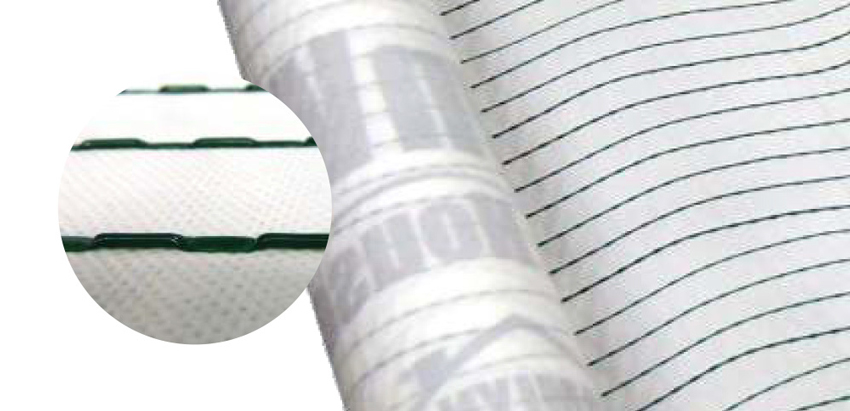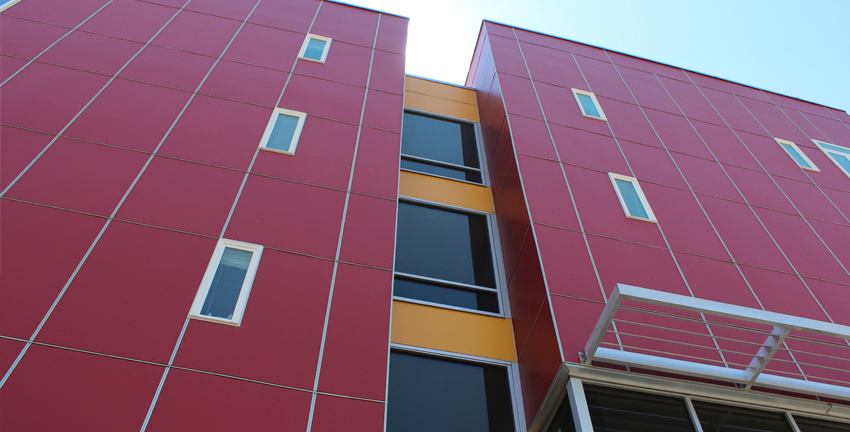Future Trends for Multifamily Housing Exteriors
A new type of innovative system combines the drainage plane and the hold-off feature in one simple application. In this system, the substrate material— the housewrap or sheet—is a two-ply product consisting of the nonwoven base material, which has a vapor-permeable, water-resistant film overlaid on to the base product. This bi-laminate product offers superior tear strength, and it places the water-resistant film at the outer layer to provide the best possible water shedding. Furthermore, filaments are bonded right to the base wrap to provide channels for moisture to drain down and away. The filaments are made from a ridged, noncompressible, polyolefin monofilament material similar to a monofilament fishing line. The filament does not flatten out when cladding is attached. Because of this, the channels that allow moisture to flow down and out remain uncompromised.
The filaments are 1.5 millimeters in height, run continuously the width and length of the drainable wrap, and are designed to provide a solid and strong hold-off of the exterior cladding material away from the “sheet” portion of the wrap, allowing effective, constant drainage. The assembly is designed to allow the forces of nature, aka gravity, to remove water down and away from the building envelope, thus preventing numerous moisture-related degradations and problems.
To ensure durability, regular compressed spaces on the filament allow drainage while providing a constant adhesion of the filament. One important factor to notice is the direction of the drainage system. Does the wrap need to be installed in one direction only for the system to drain off moisture? Or is it an omnidirectional housewrap? The application savings of the omnidirectional product could result in a valuable cost savings compared to unidirectional housewraps. Plus, the system is more fool proof and forgiving in the construction phase. It will work as engineered if it is applied horizontally or vertically.

Filaments should be 1.5 millimeters high to provide a sufficient capillary gap.
Another factor to consider in drainage wrap is the distance the wrap holds off the cladding to allow moisture to drain away. If the distance is too little, the effectiveness of the system will suffer. As an example, a 1.5-millimeter standoff from the cladding would be considered a highly effective distance that will allow the product work. And of course, the material that makes up the standoff must be noncompressible. If it is soft and pliable and flattens over time, the effectiveness of the system will likewise suffer, and the moisture will not drain away in a timely manner. A gap design of sufficient distance and durability provides a true drainage space or capillary break between the sheathing and cladding material.
Installation of Drainable Housewrap
Choosing the right housewrap requires an understanding of the product’s key attributes, including water resistance, durability, vapor permeability, and drainage. Installation is also critical.
The biggest key with any wrap or flashing is to always install in shingle fashion, so installation will begin at the base of the wall and openings and move vertically. This means that that the installer moves from the bottom of the wall and works up. Proper shingling is required to shed water and prevent water from entering the wall system.
For products with adhered filaments, commonly available scissors are preferable to a utility knife to cut the wrap. That’s because the use of a utility knife will break the bond of the filaments (spacers) to the wrap. The wrap is unrolled with the spacers facing to the exterior and fastened to the sheathing with cap fasteners. Fasteners should provide a minimum ½-inch penetration into the nail base and be spaced approximately 3 feet apart. All horizontal seams should overlap 4 inches, and vertical seams should overlap by at least 6 inches. Housewrap should extend a minimum of 2 inches over the sill plate.
Rainscreen Standards
Over the decades, building codes have evolved to ensure that moisture does not accumulate inside building envelopes. For instance, the International Residential Code (IRC) states: Exterior walls shall provide the building with a weather-resistant exterior wall envelope. The exterior wall envelope shall include flashing as described in Section R703.8. The exterior wall envelope shall be designed and constructed in such a manner that prevents the accumulation of water within the wall assembly by providing a water- resistive barrier behind the exterior veneer as required by Section R703.2 and a means of draining water that enters the assembly to the exterior (Wall Covering, Section R703: Exterior Covering and R703.1: General).
Proper specification and installation of flashings are critical factors for dry and durable building envelopes. Regarding flashings, the code says: Approved corrosion-resistive flashing shall be applied shingle fashion in such a manner to prevent entry of water into the wall cavity or penetration of water to the building structural framing components. The flashing shall extend to the surface of the exterior wall finish (Section R703.8: Flashings).
The section on exterior walls reiterates the need for moisture control and references the International Energy Conservation Code (IECC). The IRC states: Exterior walls shall provide the building with a weather-resistant exterior wall envelope. The exterior wall envelope shall include flashing, as described in Section 1405.3. The exterior wall envelope shall be designed and constructed in such a manner as to prevent the accumulation of water within the wall assembly by providing a water-resistant barrier behind the exterior veneer, as described in Section 1404.2, and a means for draining water that enters the assembly to the exterior. Protection against condensation in the exterior wall assembly shall be provided in accordance with the International Energy Conservation Code (Exterior Walls, Section 1403.2, IBC).
How Drainage Wraps and Rainscreens Open Up Possibilities for Innovative Trims
The growing use of drainable housewraps at first glance might not seem intricately related to exterior trims and reveals—but it is. In the past, architects and designers who are knowledgeable about water intrusion in the building envelope took care to minimize perforations into the exterior cladding to eliminate the potential for water or vapor getting past the cladding and then having a hard time drying out. But with a drainage plane in place, along with a method to hold the back of the cladding off the drainage plane, moisture getting past the cladding has less potential for problems. The water gets in, and the water gets out.
Trims and reveals are favorite design materials of many architects. They add interest to exteriors and provide visual relief to otherwise boring or humdrum expanses of exterior wall. Reveals and trims lend an instant contemporary aesthetic and sharpness to any exterior.
In the multifamily housing industry, where return on investment (ROI) is highly tracked and operational costs are highly considered, a building designed and constructed with superior moisture-control measures will have a better ROI than one more susceptible to moisture damage. At the same time, in a competitive market, a multifamily building with a sharp, modern aesthetic will fare better in the pricing scheme than will a building with a less remarkable appearance.
Giving Traditional Cladding a New Refined Aesthetic
Because of the sophistication and efficacy of rainscreens and drainable housewraps, architects, designers, and specifiers can confidently explore the use of metal trims and reveals without concern about damaging water intrusion into the building envelope. In fact, reveals and metal trim give new refinement and detail to such common and traditional siding materials as wood, lap sidings, composites, and others.
Materials Used for Trims and Reveals
Over the years, several materials have been used for architectural trims and reveals. Among those are polyvinyl chloride (PVC), galvanized steel, and extruded aluminum.
PVC
Originally, reveal trim profiles were developed and manufactured by an innovative building materials company with PVC to use with fiber cement siding and soffits. But through learned experiences and public demand, the industry began converting its profiles into more durable materials. The reason: dark-colored PVC will not work with dark colors. And as architects, contractors, and developers began using dark colors for many of their projects, it was apparent the 100 percent vinyl trim was susceptible to swelling and buckling when exposed to direct sunlight. That problem would become more pronounced with global climate change and extreme record-breaking weather patterns, including extreme heat.
Galvanized Steel
The use of bare galvanized steel in direct contact with most claddings will increase chances of a chemical reaction, causing wear and breakdown on both products. Also, steel is typically bent for the application, so it has limitations in shapes. That process is not as controlled as an extruded product. And when the steel is on the thinner side, that can lead to waviness in the product.
Extruded Aluminum
Aluminum extrusion is the process of shaping the aluminum by forcing it to flow through a shaped opening in a die. The extruded aluminum emerges as an elongated piece with the same profile as the die opening.

Extruded aluminum reveal profiles add durable and stylish accents to multifamily buildings.
AA 6063 is an aluminum alloy, with magnesium and silicon as the alloying elements. The Aluminum Association maintains the standard controlling its composition. It has generally good mechanical properties and is heat treatable and weldable. 6063 is the most common alloy used for aluminum extrusion.
Extruded aluminum trim is typically fabricated from custom die-extruded heavy-duty 6063 T-5 aluminum alloy with a coating that protects against harsh weather conditions and allows for paint adhesion.
The trim and reveal made from extruded aluminum are typically designed to match color and dimensions of the country’s major cementitious siding manufacturers and a number of other materials. These pieces replace the time-consuming cutting and ripping of fiber cement panels or boards for trim use.
Extruded aluminum poses no health or physical hazard. Note that aluminum trim products are defined as “articles” by the Occupational Safety and Health Administration (OSHA) and are therefore exempt from the requirement of publishing material safety data sheets.









